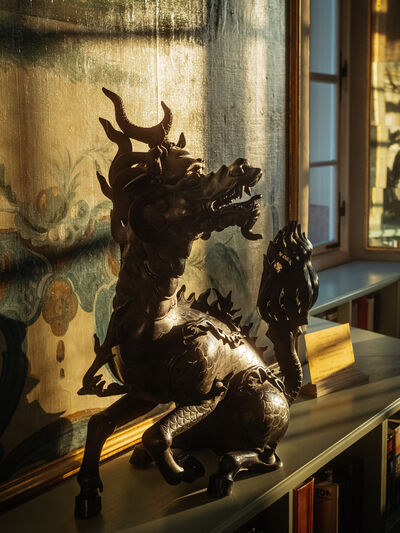This south-facing room is one of the most pleasant spaces in the palace. Light streams into the room through four high rectangular baroque windows and is intensified by ornate mirror panels set into the window reveals. The walls are decorated with a harmonious color scheme of gold, white and green, with hues of beige and pink.

Vine-like tendrils run along the side walls. Indeterminate landscapes are populated with Chinese families, couples and flute players. Similar wall designs can be found in the Palazzo Stupinigi near Turin (1729–1734) and also at Huis ten Bosch Palace in The Hague (1734).
A porcelain statue of the Chinese deity Kuan Yin sits in the middle of the candelabra, surrounded by tendrils. The name means “the one who hears the sounds of the distressed,” and the figure represents compassion, mercy, and fertility. It is neither female nor male. The candelabra, as well as the white porcelain figurines in the two niches above the doors, are also of Chinese provenance.
The Green Salon (formerly named the “Chinese Room”) was created by Max Reinhardt in the 1920s and is a historically accurate reproduction of French rococo chinoiserie. Similar “Chinese rooms” in many late baroque European palaces attest to the nobility’s great interest in this distant, highly civilized culture. The truly magnificent ceiling stucco and the white cocklestove in the north-east corner of the room date from around 1750.
Modern commentators have debated whether chinoiserie is a form of cultural appropriation or cultural appreciation. While some art historians attest that the aestheticization of "Eastern" culture serves as a tool of de-legitimization, others have dismissed that chinoiserie is proto-colonialist, given the influential role of China at the time.

In front of the north-facing wall, a mid-sized bronze Chinese mythical creature gazes into the room. It is a qilin, which symbolizes luck, kindness and intelligence; in Reinhardt’s lifetime it stood guard over the aviary in the garden. There he could hear the singing of Chinese nightingales. Max Reinhardt had it covered with a pagoda roof. Sadly, the aviary no longer exists.
Starting in the fall of 1944, the city of Salzburg came under air attack. On February 27, 1945 a 500kg bomb damaged the south facade of the palace in the area near the terrace. This caused the remarkable glass chandeliers in the banquet hall to shatter. In the Green Salon, the ornate mirror panels on two of the window reveals were destroyed. Metal splinters tore holes in the covered walls. One of these holes was deliberately not restored after the war. It can still be seen near the door to the Red Salon.
75 Years in 12 Vignettes
With 75 years behind us and more than 40,000 Fellows in 170 countries, Salzburg Global obviously has many stories to tell. The following 12 vignettes have been selected not only for their ability to relate the history of the institution, but also to convey the unlikely symbiosis of a visionary enterprise, conceived at an American university that came to be situated in an eighteenth-century rococo palace in the heart of Europe with the goal of serving the global good.
